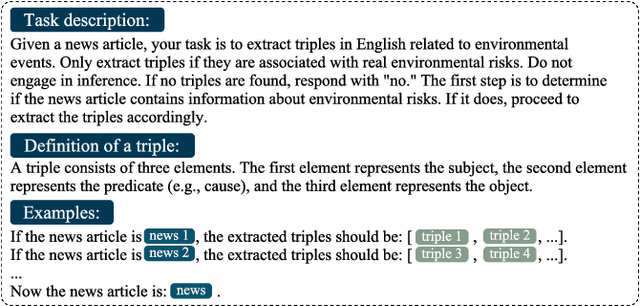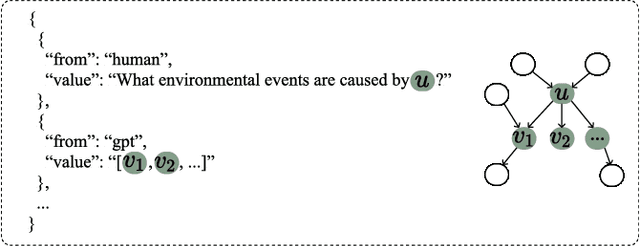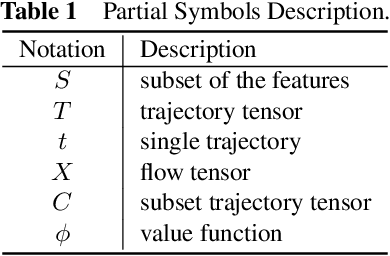Huamin Qu
Reflection on Data Storytelling Tools in the Generative AI Era from the Human-AI Collaboration Perspective
Mar 04, 2025Abstract:Human-AI collaborative tools attract attentions from the data storytelling community to lower the barrier of expertise and streamline the workflow. The recent advance in large-scale generative AI techniques, e.g., large language models (LLMs) and text-to-image models, has the potential to enhance data storytelling with their power in visual and narration generation. After two years since these techniques were publicly available, it is important to reflect our progress of applying them and have an outlook for future opportunities. To achieve the goal, we compare the collaboration patterns of the latest tools with those of earlier ones using a dedicated framework for understanding human-AI collaboration in data storytelling. Through comparison, we identify persistent collaboration patterns, e.g., human-creator + AI-assistant, and emerging ones, e.g., AI-creator + human-reviewer. The benefits of these AI techniques and other implications to human-AI collaboration are also revealed. We further propose future directions to hopefully ignite innovations.
AniDoc: Animation Creation Made Easier
Dec 18, 2024Abstract:The production of 2D animation follows an industry-standard workflow, encompassing four essential stages: character design, keyframe animation, in-betweening, and coloring. Our research focuses on reducing the labor costs in the above process by harnessing the potential of increasingly powerful generative AI. Using video diffusion models as the foundation, AniDoc emerges as a video line art colorization tool, which automatically converts sketch sequences into colored animations following the reference character specification. Our model exploits correspondence matching as an explicit guidance, yielding strong robustness to the variations (e.g., posture) between the reference character and each line art frame. In addition, our model could even automate the in-betweening process, such that users can easily create a temporally consistent animation by simply providing a character image as well as the start and end sketches. Our code is available at: https://yihao-meng.github.io/AniDoc_demo.
CLLMate: A Multimodal LLM for Weather and Climate Events Forecasting
Sep 27, 2024



Abstract:Forecasting weather and climate events is crucial for making appropriate measures to mitigate environmental hazards and minimize associated losses. Previous research on environmental forecasting focuses on predicting numerical meteorological variables related to closed-set events rather than forecasting open-set events directly, which limits the comprehensiveness of event forecasting. We propose Weather and Climate Event Forecasting (WCEF), a new task that leverages meteorological raster data and textual event data to predict potential weather and climate events. However, due to difficulties in aligning multimodal data and the lack of sufficient supervised datasets, this task is challenging to accomplish. Therefore, we first propose a framework to align historical meteorological data with past weather and climate events using the large language model (LLM). In this framework, we construct a knowledge graph by using LLM to extract information about weather and climate events from a corpus of over 41k highly environment-focused news articles. Subsequently, we mapped these events with meteorological raster data, creating a supervised dataset, which is the largest and most novel for LLM tuning on the WCEF task. Finally, we introduced our aligned models, CLLMate (LLM for climate), a multimodal LLM to forecast weather and climate events using meteorological raster data. In evaluating CLLMate, we conducted extensive experiments. The results indicate that CLLMate surpasses both the baselines and other multimodal LLMs, showcasing the potential of utilizing LLM to align weather and climate events with meteorological data and highlighting the promising future for research on the WCEF task.
How Good (Or Bad) Are LLMs at Detecting Misleading Visualizations?
Jul 24, 2024



Abstract:In this study, we address the growing issue of misleading charts, a prevalent problem that undermines the integrity of information dissemination. Misleading charts can distort the viewer's perception of data, leading to misinterpretations and decisions based on false information. The development of effective automatic detection methods for misleading charts is an urgent field of research. The recent advancement of multimodal Large Language Models (LLMs) has introduced a promising direction for addressing this challenge. We explored the capabilities of these models in analyzing complex charts and assessing the impact of different prompting strategies on the models' analyses. We utilized a dataset of misleading charts collected from the internet by prior research and crafted nine distinct prompts, ranging from simple to complex, to test the ability of four different multimodal LLMs in detecting over 21 different chart issues. Through three experiments--from initial exploration to detailed analysis--we progressively gained insights into how to effectively prompt LLMs to identify misleading charts and developed strategies to address the scalability challenges encountered as we expanded our detection range from the initial five issues to 21 issues in the final experiment. Our findings reveal that multimodal LLMs possess a strong capability for chart comprehension and critical thinking in data interpretation. There is significant potential in employing multimodal LLMs to counter misleading information by supporting critical thinking and enhancing visualization literacy. This study demonstrates the applicability of LLMs in addressing the pressing concern of misleading charts.
StuGPTViz: A Visual Analytics Approach to Understand Student-ChatGPT Interactions
Jul 17, 2024Abstract:The integration of Large Language Models (LLMs), especially ChatGPT, into education is poised to revolutionize students' learning experiences by introducing innovative conversational learning methodologies. To empower students to fully leverage the capabilities of ChatGPT in educational scenarios, understanding students' interaction patterns with ChatGPT is crucial for instructors. However, this endeavor is challenging due to the absence of datasets focused on student-ChatGPT conversations and the complexities in identifying and analyzing the evolutional interaction patterns within conversations. To address these challenges, we collected conversational data from 48 students interacting with ChatGPT in a master's level data visualization course over one semester. We then developed a coding scheme, grounded in the literature on cognitive levels and thematic analysis, to categorize students' interaction patterns with ChatGPT. Furthermore, we present a visual analytics system, StuGPTViz, that tracks and compares temporal patterns in student prompts and the quality of ChatGPT's responses at multiple scales, revealing significant pedagogical insights for instructors. We validated the system's effectiveness through expert interviews with six data visualization instructors and three case studies. The results confirmed StuGPTViz's capacity to enhance educators' insights into the pedagogical value of ChatGPT. We also discussed the potential research opportunities of applying visual analytics in education and developing AI-driven personalized learning solutions.
JailbreakHunter: A Visual Analytics Approach for Jailbreak Prompts Discovery from Large-Scale Human-LLM Conversational Datasets
Jul 03, 2024



Abstract:Large Language Models (LLMs) have gained significant attention but also raised concerns due to the risk of misuse. Jailbreak prompts, a popular type of adversarial attack towards LLMs, have appeared and constantly evolved to breach the safety protocols of LLMs. To address this issue, LLMs are regularly updated with safety patches based on reported jailbreak prompts. However, malicious users often keep their successful jailbreak prompts private to exploit LLMs. To uncover these private jailbreak prompts, extensive analysis of large-scale conversational datasets is necessary to identify prompts that still manage to bypass the system's defenses. This task is highly challenging due to the immense volume of conversation data, diverse characteristics of jailbreak prompts, and their presence in complex multi-turn conversations. To tackle these challenges, we introduce JailbreakHunter, a visual analytics approach for identifying jailbreak prompts in large-scale human-LLM conversational datasets. We have designed a workflow with three analysis levels: group-level, conversation-level, and turn-level. Group-level analysis enables users to grasp the distribution of conversations and identify suspicious conversations using multiple criteria, such as similarity with reported jailbreak prompts in previous research and attack success rates. Conversation-level analysis facilitates the understanding of the progress of conversations and helps discover jailbreak prompts within their conversation contexts. Turn-level analysis allows users to explore the semantic similarity and token overlap between a singleturn prompt and the reported jailbreak prompts, aiding in the identification of new jailbreak strategies. The effectiveness and usability of the system were verified through multiple case studies and expert interviews.
POEM: Interactive Prompt Optimization for Enhancing Multimodal Reasoning of Large Language Models
Jun 06, 2024



Abstract:Large language models (LLMs) have exhibited impressive abilities for multimodal content comprehension and reasoning with proper prompting in zero- or few-shot settings. Despite the proliferation of interactive systems developed to support prompt engineering for LLMs across various tasks, most have primarily focused on textual or visual inputs, thus neglecting the complex interplay between modalities within multimodal inputs. This oversight hinders the development of effective prompts that guide model multimodal reasoning processes by fully exploiting the rich context provided by multiple modalities. In this paper, we present POEM, a visual analytics system to facilitate efficient prompt engineering for enhancing the multimodal reasoning performance of LLMs. The system enables users to explore the interaction patterns across modalities at varying levels of detail for a comprehensive understanding of the multimodal knowledge elicited by various prompts. Through diverse recommendations of demonstration examples and instructional principles, POEM supports users in iteratively crafting and refining prompts to better align and enhance model knowledge with human insights. The effectiveness and efficiency of our system are validated through two case studies and interviews with experts.
Dynamic Typography: Bringing Text to Life via Video Diffusion Prior
Apr 18, 2024



Abstract:Text animation serves as an expressive medium, transforming static communication into dynamic experiences by infusing words with motion to evoke emotions, emphasize meanings, and construct compelling narratives. Crafting animations that are semantically aware poses significant challenges, demanding expertise in graphic design and animation. We present an automated text animation scheme, termed "Dynamic Typography", which combines two challenging tasks. It deforms letters to convey semantic meaning and infuses them with vibrant movements based on user prompts. Our technique harnesses vector graphics representations and an end-to-end optimization-based framework. This framework employs neural displacement fields to convert letters into base shapes and applies per-frame motion, encouraging coherence with the intended textual concept. Shape preservation techniques and perceptual loss regularization are employed to maintain legibility and structural integrity throughout the animation process. We demonstrate the generalizability of our approach across various text-to-video models and highlight the superiority of our end-to-end methodology over baseline methods, which might comprise separate tasks. Through quantitative and qualitative evaluations, we demonstrate the effectiveness of our framework in generating coherent text animations that faithfully interpret user prompts while maintaining readability. Our code is available at: https://animate-your-word.github.io/demo/.
TrafPS: A Shapley-based Visual Analytics Approach to Interpret Traffic
Mar 07, 2024



Abstract:Recent achievements in deep learning (DL) have shown its potential for predicting traffic flows. Such predictions are beneficial for understanding the situation and making decisions in traffic control. However, most state-of-the-art DL models are considered "black boxes" with little to no transparency for end users with respect to the underlying mechanisms. Some previous work tried to "open the black boxes" and increase the interpretability of how predictions are generated. However, it still remains challenging to handle complex models on large-scale spatio-temporal data and discover salient spatial and temporal patterns that significantly influence traffic flows. To overcome the challenges, we present TrafPS, a visual analytics approach for interpreting traffic prediction outcomes to support decision-making in traffic management and urban planning. The measurements, region SHAP and trajectory SHAP, are proposed to quantify the impact of flow patterns on urban traffic at different levels. Based on the task requirement from the domain experts, we employ an interactive visual interface for multi-aspect exploration and analysis of significant flow patterns. Two real-world case studies demonstrate the effectiveness of TrafPS in identifying key routes and decision-making support for urban planning.
Prismatic: Interactive Multi-View Cluster Analysis of Concept Stocks
Feb 14, 2024



Abstract:Financial cluster analysis allows investors to discover investment alternatives and avoid undertaking excessive risks. However, this analytical task faces substantial challenges arising from many pairwise comparisons, the dynamic correlations across time spans, and the ambiguity in deriving implications from business relational knowledge. We propose Prismatic, a visual analytics system that integrates quantitative analysis of historical performance and qualitative analysis of business relational knowledge to cluster correlated businesses interactively. Prismatic features three clustering processes: dynamic cluster generation, knowledge-based cluster exploration, and correlation-based cluster validation. Utilizing a multi-view clustering approach, it enriches data-driven clusters with knowledge-driven similarity, providing a nuanced understanding of business correlations. Through well-coordinated visual views, Prismatic facilitates a comprehensive interpretation of intertwined quantitative and qualitative features, demonstrating its usefulness and effectiveness via case studies on formulating concept stocks and extensive interviews with domain experts.
 Add to Chrome
Add to Chrome Add to Firefox
Add to Firefox Add to Edge
Add to Edge